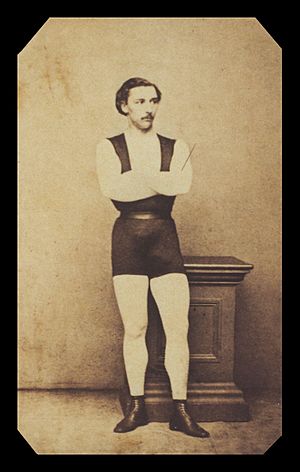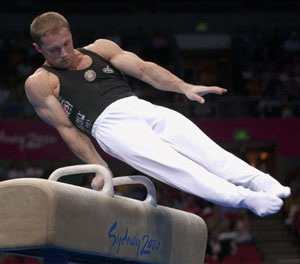Leotard facts for kids

A leotard is a tight, one-piece clothing item. It covers your body from your shoulders down to your crotch. This special garment was made popular by a French acrobat named Jules Léotard (1838–1870). You can find leotards with no sleeves, short sleeves, or long sleeves. A similar item is the unitard, which also covers the legs.
Leotards are worn by many different performers and athletes. These include acrobats, gymnasts, dancers, figure skaters, and circus performers. They use leotards for practice and as part of their show costumes. Dancers often wear leotards with ballet skirts on top. They might also wear tights or bike shorts underneath. For everyday wear, a leotard can be worn with a belt. It can also be worn under overalls or short skirts.
To put on a leotard, you step into the leg holes first. Then, you pull the sleeves over your shoulders. Some leotards have a wide, round neck opening. They stay in place because the fabric is stretchy. Others have a crew neck or polo neck and close at the back with a zipper or snaps.
Contents
What Are Leotards Used For?
Leotards are used for many activities. People wear them for yoga, exercise, and dance. They are very popular for ballet and modern dance. Some people even use them as pajamas or for extra warmth under clothes. Leotards can also be worn as a casual top. Kids often wear them for dress-up and play.
Leotards are common in figure skating, gymnastics, and ballet. Young children especially wear them for these sports. Practice leotards usually do not have sleeves. For competitions, female gymnasts and skaters almost always wear long-sleeved leotards. Male gymnasts might wear sleeved or sleeveless leotards. Sleeveless is more common in gymnastics. Leotards come in many styles. Some have a full bottom, while others are a thong style. This helps avoid visible panty lines under leggings or tights.
The History of Leotards

The word "leotard" was first used in 1886. This was many years after Jules Léotard had passed away. Léotard himself called the garment a maillot. This French word means a tight-fitting shirt or sports shirt. In the early 1900s, leotards were mostly seen in circus and acrobatic shows. Only performers wore them.
In the 1920s and 1930s, leotards influenced swimsuit styles. Today's one-piece swimsuits still look a lot like leotards. Professional dancers, like showgirls on Broadway, also wear leotards. On stage, leotards are often worn with stockings or tights.
By the 1950s, leotards were still worn by performers. But they also started to be used for exercise. Schools and fitness centers used them as simple workout clothes. These were usually black and worn with thick tights. Between 1950 and 1970, leotards looked pretty much the same. Then, in the 1970s, more colorful leotards appeared. These were popular in ballet and exercise.
During the 1970s and 1980s, leotards were widely used for aerobic exercise. In the 1990s, they were replaced by Lycra pants. These were similar to cycling uniforms. By the 2000s, trousers and leggings took their place. However, women cyclists and athletes still wear leotards in competitions.
Leotards in Everyday Fashion
By the late 1970s, leotards became popular for both exercise and street wear. The disco craze and aerobics fashion helped this trend. These leotards were made from new materials like nylon and spandex. Older ones were usually cotton. Exercise videos by stars like Jane Fonda also made leotards popular.
Dancewear companies like Danskin grew a lot during this time. They made many leotards for dance and everyday wear. Other companies, like Gilda Marx, stopped making leotards when they went out of style. By the late 1980s, exercise leotards often looked like bikini bottoms with shoulder straps. They were usually worn with cropped shirts.
From the mid-1980s to mid-1990s, leotards were popular as tops. They often had cap sleeves or a long-sleeved turtleneck style. People wore them with jeans, especially skinny jeans or high-waisted "mom jeans." They were also worn under shortalls or with dress pants. By the mid-1990s, sports bras and shorts mostly replaced leotards for exercise.
Leotards are very versatile. They can be dressed up or down. The picture of Beyoncé shows a stage costume. Her leotard is covered in sequins and sparkles. For exercise, leotards are often seen with T-shirts, crop tops, and tights.
Gymnastics Attire
Women's Gymnastics Leotards

For female gymnasts, the standard competition uniform is a leotard. Traditionally, competition leotards had long sleeves. However, now half-length sleeves and sleeveless leotards are allowed. Teams have worn them at the World Gymnastics Championships. Practice leotards are usually sleeveless.
In the 1970s, leotards were made from polyester. Since the 1980s, they have been made from lycra or spandex. Since the 1990s, leotards have become more fancy. They use different fabrics like velvet, mesh, and metallic materials. They can also be decorated with rhinestones and jewels. These are heat-set onto the fabric so they won't fall off.
There are rules about how leotards can be cut. They cannot be cut too high on the hip or too low on the back. See-through leotards are also against the rules. White tights are not standard. Sometimes, gymnasts get points taken off their score if their outfit breaks the rules.
Men's Gymnastics Uniforms
For competitions, male gymnasts wear two layers. The first layer is a singlet. This is a sleeveless leotard. For floor and vault events, gymnasts wear very short shorts over the singlet. For other events, they wear long pants. These pants have stirrups that go under their feet.
Unlike women's uniforms, men's uniforms are usually plain. They are less shiny and decorated. Singlets often use one or more of the national team colors. But there are no strict rules on the design. Shorts and pants are usually a solid color. Common colors are white, blue, red, or black.
Evolution of Gymnastics Leotards
Olympic gymnastics leotards have changed a lot over time. The main goal of leotards has also changed. At first, they were meant to cover as much of a woman's body as possible. Today, leotards need to be breathable. They also need to help with aerodynamics. They must stretch and move easily as athletes perform difficult routines.
Leotards for Men
When Jules Léotard created the maillot, it was made for men. This type of leotard can be seen in old photos of circus 'strong man' performers. Men's leotards changed over time, becoming similar to women's styles. The men's version had a slightly lower leg opening and a lower front cut.
Men's leotards come in two styles. One has a full bottom, and the other is a thong style. The thong style is used when worn with tights, like in ballet. This is to prevent lines from showing under the tights. In these cases, a dance belt is also worn.
Leotards are commonly worn by male dancers, especially for ballet. Gymnasts also wear them. Leotard-like clothes, such as "biketards" or singlets, are worn by men in sports like rowing, wrestling, cycling, and running. This helps the clothing stay tight and prevents the top from riding up.
See also
In Spanish: Leotardo para niños




